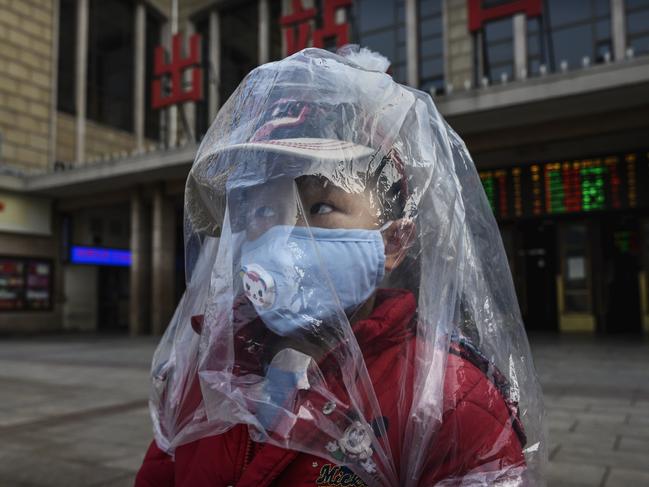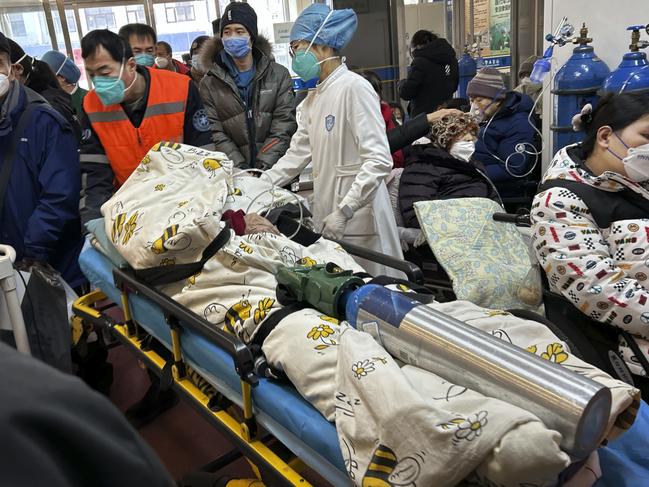China pneumonia outbreak: Denmark, Netherlands and Sweden reporting surge in cases
Several European countries have reported a surge in cases of pneumonia in children after an outbreak in China.
Illness
Don't miss out on the headlines from Illness. Followed categories will be added to My News.
Pneumonia cases have spread to Europe after an outbreak in China sparking speculation of a new pandemic threat four years after the emergence of Covid-19.
Cases in children are reaching “epidemic levels” in Denmark while the Netherlands and Sweden are also experiencing a surge.
Denmark’s Statens Serum Institut said rates have tripled over the past five weeks with many more cases expected over the course of winter.
The Netherlands Institute for Health Services Research reported that 80 out of every 100,000 children aged 5 to 14 had pneumonia last week.
The outbreak, dubbed “white lung syndrome” because of how the lung damage shows up on scans, spreads through coughing, sneezing talking, singing and breathing – through tiny respiratory droplets.
The sickness can’t always be treated with antibiotics, however, making it more dangerous for younger children.

The World Health Organisation is pressing China to provide more information as the country grapples with a surge in pneumonia in children.
Dr Maria Van Kerkhove, a WHO epidemiologist, said the agency was “following up with China” amid reports the nation’s hospitals were being overwhelmed with sick children.
Dr Van Kerkhove told reporters: “Yes, we are seeing an increase in respiratory infections around the world.
“We’re in autumn and entering winter months, so we are expecting to see rises in respiratory infections regardless.
“We are following up with China. They are seeing an increase due a number of different infections.”
She said the WHO is chasing updates from their clinical network and clinicians in China.
“In terms of acute respiratory infections, we are looking at the burden on healthcare systems and looking at the healthcare capacities of systems,” she added.
Christine Jenkins, a professor of medicine at the University of New South Wales, said WHO’s query and the public nature of the request was “a little unusual”, but “not surprising”.
“When infections like these, such as [when the] first SARS occurred and subsequently when [SARS-CoV-2] occurred in China, initially it was exceptionally difficult to get information,” she said, the ABC reports.
“I think the WHO is taking a much more proactive approach to surveillance,” Prof Jenkins said.
Chinese health authorities have said the rising infections are a mix of already known viruses and are linked to the country’s first full cold season after strict Covid restrictions were lifted last December.
And experts say there is little to suggest the cases were caused by a new virus but emphasised that the full situation remains unclear.
Here is what we know so far.
WHAT AND WHERE?
On November 13, China’s National Health Commission reported a surge of respiratory illnesses, mostly in children.
Chinese authorities have attributed the rising cases to the end of Covid restrictions, the arrival of the cold season, and the circulation of known pathogens including influenza, mycoplasma pneumonia, respiratory syncytial virus (RSV) and SARS-CoV-2 – the virus that causes Covid.
The public disease surveillance system ProMED – which once issued an early warning about mysterious pneumonia cases that turned out to be Covid – reported that some Chinese hospitals were “overwhelmed with sick children” due to a pneumonia outbreak.
This outbreak was said to be mainly in the capital Beijing, but also in the northeastern Liaoning province and other areas in China.
Symptoms included fever, lung inflammation without a cough, and pulmonary nodules – lumps on lungs that are usually the result of a past infection. No deaths have been reported.
At a children’s hospital in Beijing, several parents told AFP their children had mycoplasma pneumonia, which is a common cause of pneumonia in children that is readily treated with antibiotics.

WHAT DO CHINA AND WHO SAY?
The report triggered memories of the pandemic, with social media users fearing “a new virus coming from China,” or a “new Covid”.
The World Health Organisation – which repeatedly criticised Beijing for a lack of transparency throughout the Covid pandemic – requested more information from China about children suffering from “undiagnosed pneumonia”.
Beijing responded, saying “there has been no detection of any unusual or novel pathogens,” according to a WHO statement.
The WHO has requested more information, noting that China closely monitors trends in viruses such as the flu, RSV and SARS-CoV-2.
China also started monitoring mycoplasma pneumonia for the first time in mid-October, the WHO added.
The WHO said that “there is limited detailed information available to fully characterise the overall risk of these reported cases of respiratory illness in children.”
However an increase in such illnesses was to be expected with the arrival of winter, it added.
WHAT DO EXPERTS THINK?
Several experts pointed to winter’s arrival, the end of Covid restrictions, and a lack of prior immunity in children as likely being behind the surging infections.
“Since China experienced a far longer and harsher lockdown than essentially any other country on Earth, it was anticipated that those ‘lockdown exit’ waves could be substantial in China,” said Francois Balloux of University College London.
Unless there is new evidence suggesting otherwise, “there is no reason to suspect the emergence of a novel pathogen,” he added.
Paul Hunter of the UK’s University of East Anglia emphasised that “at present there is too little information to make a definitive diagnosis”.
However “overall, this does not sound to me like an epidemic due to a novel virus,” he added.
“If it was, I would expect to see many more infections in adults. The few infections reported in adults suggest existing immunity from a prior exposure.”
Catherine Bennett of Deakin University in Melbourne pointed out that “young children in school in China will have spent up to half their life without the usual exposure to common pathogens, and so do not have the same levels of immunity”.
ARE THERE ANY RECOMMENDATIONS?
The WHO recommended that people in the affected areas follow the normal rules to avoid respiratory illnesses.
These include getting vaccinated, isolating if symptoms emerge, and getting tested or wearing masks if necessary.
Based on the current information, the WHO advised against any travel restrictions involving China.
Originally published as China pneumonia outbreak: Denmark, Netherlands and Sweden reporting surge in cases
Read related topics:Explainers


